Iceland E-commerce Market Size
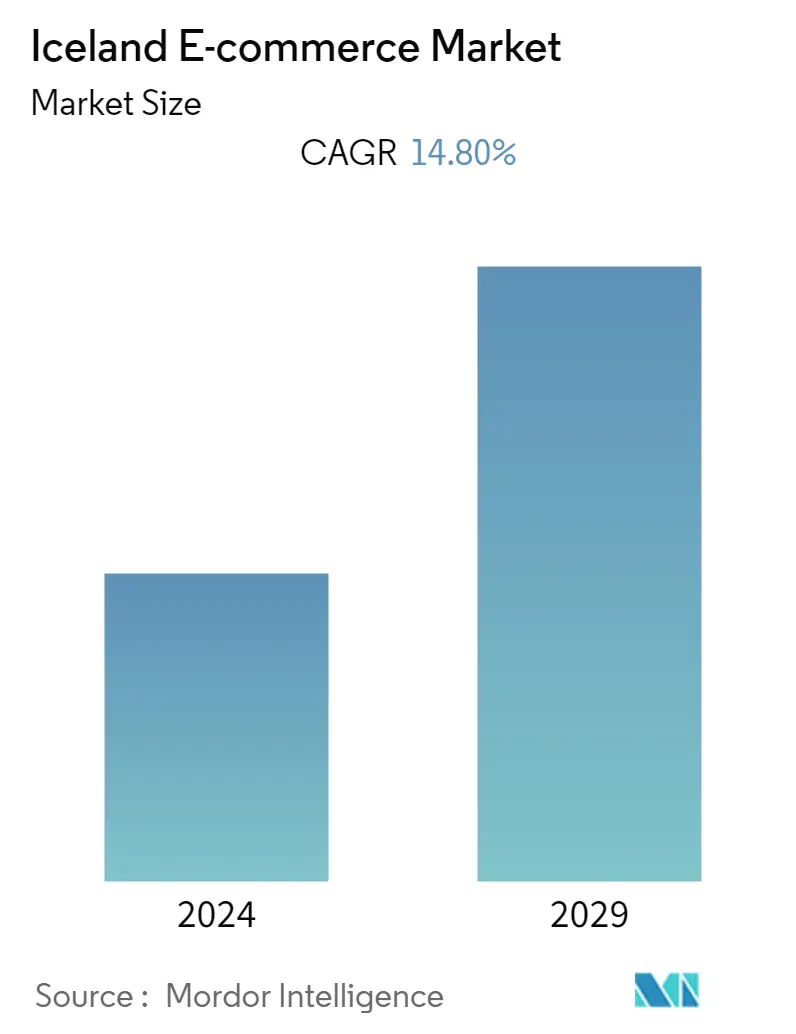
| Study Period | 2019 - 2029 |
| Base Year For Estimation | 2023 |
| Forecast Data Period | 2024 - 2029 |
| Historical Data Period | 2019 - 2022 |
| CAGR | 14.80 % |
| Market Concentration | Low |
Major Players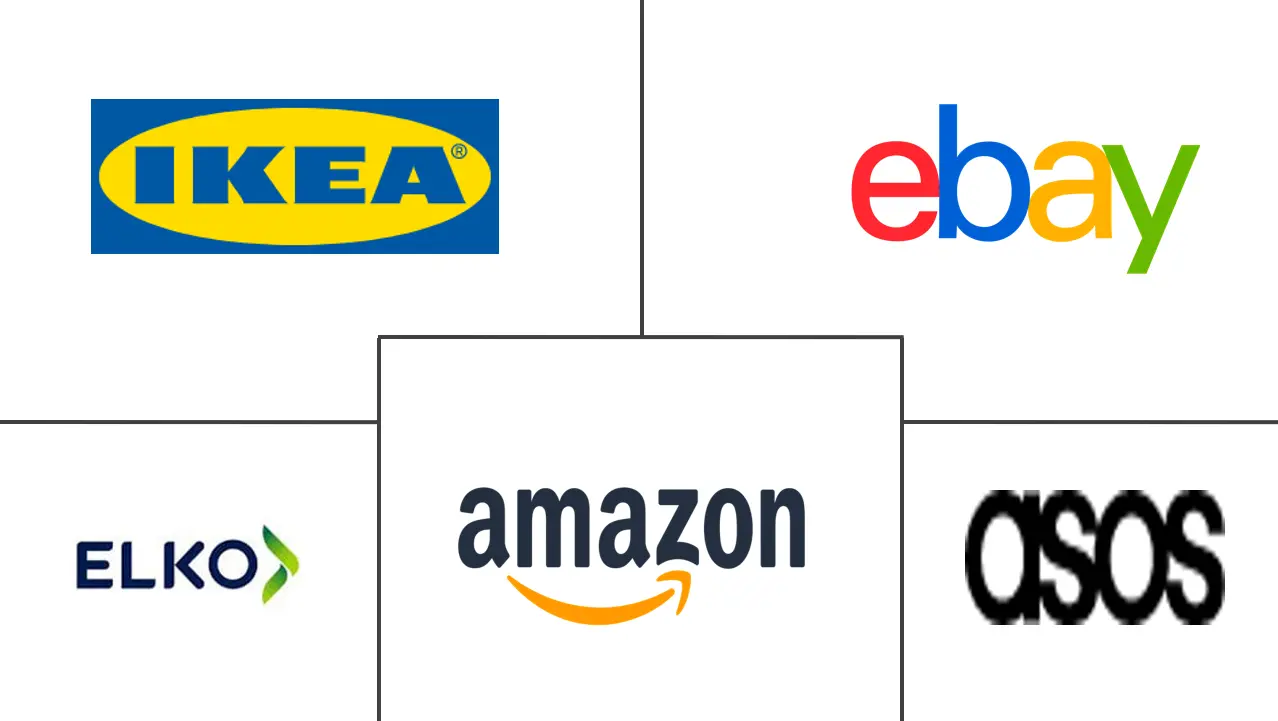
*Disclaimer: Major Players sorted in no particular order |
Need a report that reflects how COVID-19 has impacted this market and its growth?
Iceland E-commerce Market Analysis
The Iceland e-commerce market is expected to register a CAGR of 14.8% during the period 2022-2027. The primary factor driving the growth of the market in the region is the high rate of urbanization and intense Internet penetration, among others.
- Icelanders have very high internet usage, close to 99%, and in the past couple of years, online shopping has increased significantly, both from abroad and locally. Foreign e-commerce platforms are prevalent in Iceland, offering low-cost products across the region. The consumers in Iceland are also increasingly purchasing goods from American and European retailers, mainly fashion-related products, baby and beauty products, and electronic equipment.
- Furthermore, the high rate of urbanization, close to 94% (as reported by Hootsuite), is also paving the way for better infrastructure for the delivery of products by e-commerce companies in the region. With the high-tech and IT industries flourishing in Iceland, e-commerce is rapidly growing in Iceland as companies are increasingly offering their services online. This is further expected to boost the e-commerce market in the region.
- Digital marketing is widely used in Iceland. Many smaller e-commerce companies only advertise on social media, primarily Facebook, and many use social media influencers for marketing their products and services. Larger and more established e-commerce companies use digital marketing with a combination of conventional marketing.
- However, Iceland follows European e-commerce rules and regulations. A significant hindrance for online businesses in the region is high shipping costs, a high percentage of Value Added Tax (VAT), and handling fees charged by the local postal services, which can hamper the growth of the e-commerce market in the region.
- At the time of the COVID-19 pandemic, when most of the physical and brick-and-mortar stores were closed, the e-commerce market in the region grew owing to an increase in the strong demand for groceries, home furnishing, and pharmacy products. Many brick-and-mortar businesses introduced online channels for shopping in the region.
Iceland E-commerce Market Trends
This section covers the major market trends shaping the Iceland E-commerce Market according to our research experts:
Growing Number of E-shoppers is Expected to Boost the E-commerce Market
- The number of online or e-shoppers is rapidly increasing in the region owing to the intense internet penetration and high rate of urbanization. Furthermore, after the pandemic, consumer preference shift from offline shopping to online shopping boosts the number of e-shoppers in the region.
- As per data reported by EUROSTAT, the percentage of internet users that bought goods or services online was 76% in 2018; this percentage grew to 83% owing to the increased online shopping during the COVID-19 pandemic. Furthermore, the rate of online shoppers increased by 2% in 2021.
- Moreover, with high mobile and internet penetration in the region, digital wallets are gaining traction as one of the most popular online payment methods for online shopping in Iceland, especially since Icelanders are keen to do their banking and buy from their smartphones. The ease of convenience provided by this method is also attracting online shopping in the region.
- Furthermore, as per STATCOUNTER, 75% population in Iceland uses Facebook as a social media platform. Many players in the region are extensively doing digital advertising on these social media platforms to gain new consumers for online shopping. This is further expected to drive the e-commerce market in the region.
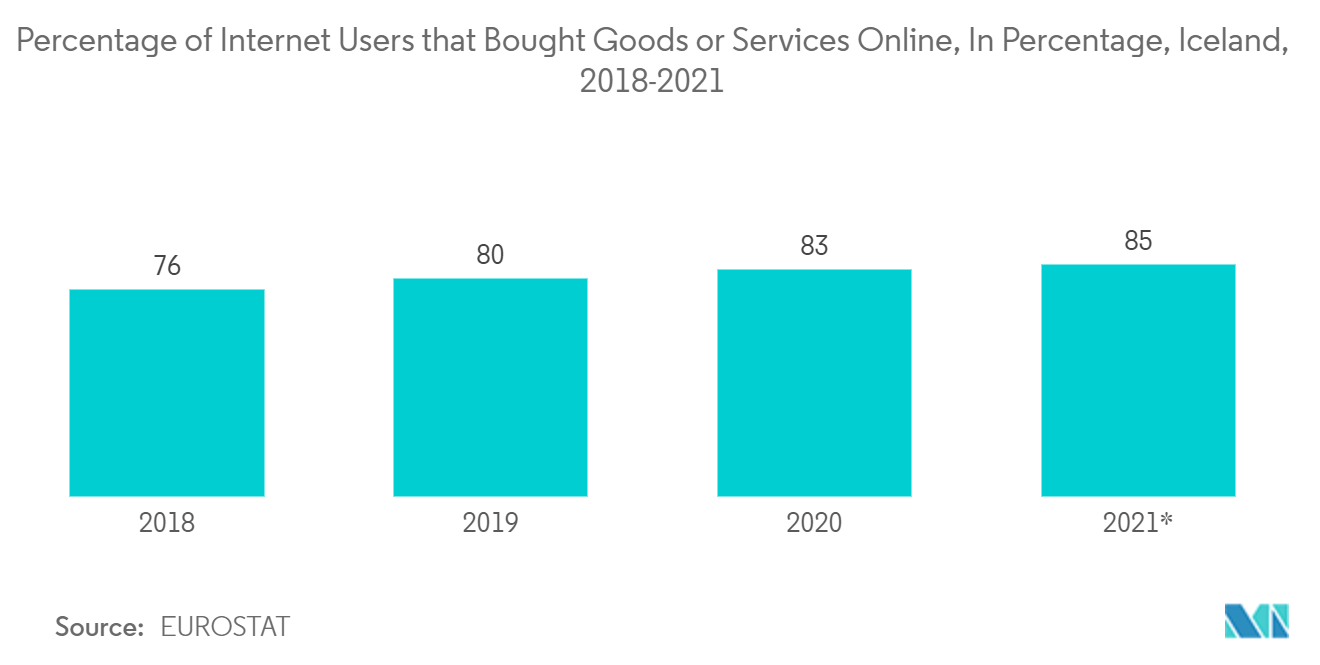
The Fashion and Apparel Segment Accounted for the Largest Market Share
- One of the crucial trends in the fashion segment is the direct integration of shopping functionality into the content display on social media, enabling high-speed, inspiring, and selling customer conversion (e.g., Instagram Checkout). The audience is increasingly shifting from desktop to mobile, and improving the mobile browsing and checkout experience is crucial.
- Clothing, sports goods, and footwear online sales in the region generate a significant amount of share for the e-commerce market in the region. Further supported by mobile commerce, which makes up a significant proportion of Iceland's e-commerce market and is expected to surpass desktop usage in coming years. E-commerce merchants in the region are offering mobile optimization and a great mobile buying experience for online purchasing in the region.
- Furthermore, the household expenditure on clothing is continuously increasing in the region due to the increasing demand for fashion sector products, including clothing and apparel. For instance, as reported by Statistics Iceland, the annual household consumption expenditure on clothing in Iceland dramatically increased from 31,245 ISK million in 2015 to 42,268 ISK million in 2020.
- All of the aforementioned factors are expected to boost the E-commerce market in the region over the forecast period.
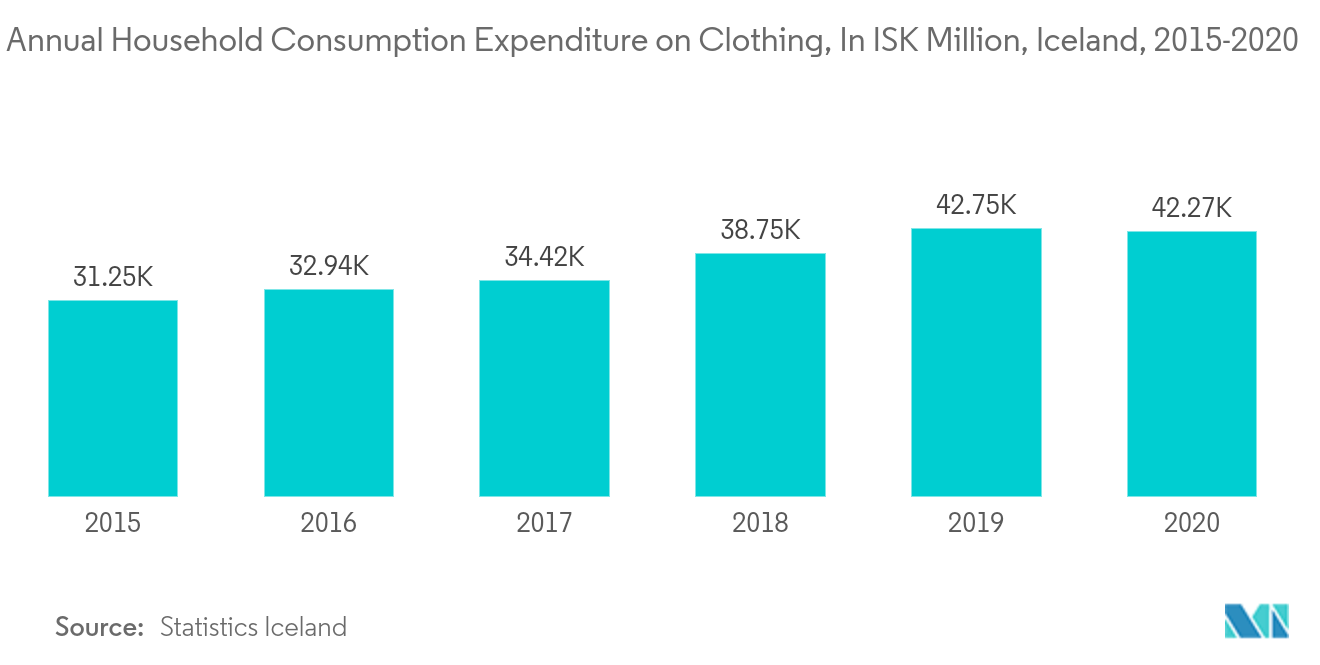
Iceland E-commerce Industry Overview
Competition intensifies in Iceland's e-commerce market as demand for online retail grows. The Iceland eE-commerce market is fragmented owing to the presence of a large number of players. Major players in the Iceland e-commerce market include Amazon Inc. and Ebay Inc.
- February 2022- Iceland Foods announced to extend the benefits of its Bonus Card loyalty scheme to online shoppers. Iceland's Bonus Card acts as a payment card for shopping. Customers top it up from a debit or credit card. Previously, consumers have only been able to use the Bonus Card to pay in stores, but they can now use it for online shopping at Iceland.co.uk too.
Iceland E-commerce Market Leaders
Amazon.com, Inc.
Inter IKEA Systems B.V
Elko ehf
eBay Inc.
ASOS.com, Ltd.
*Disclaimer: Major Players sorted in no particular order
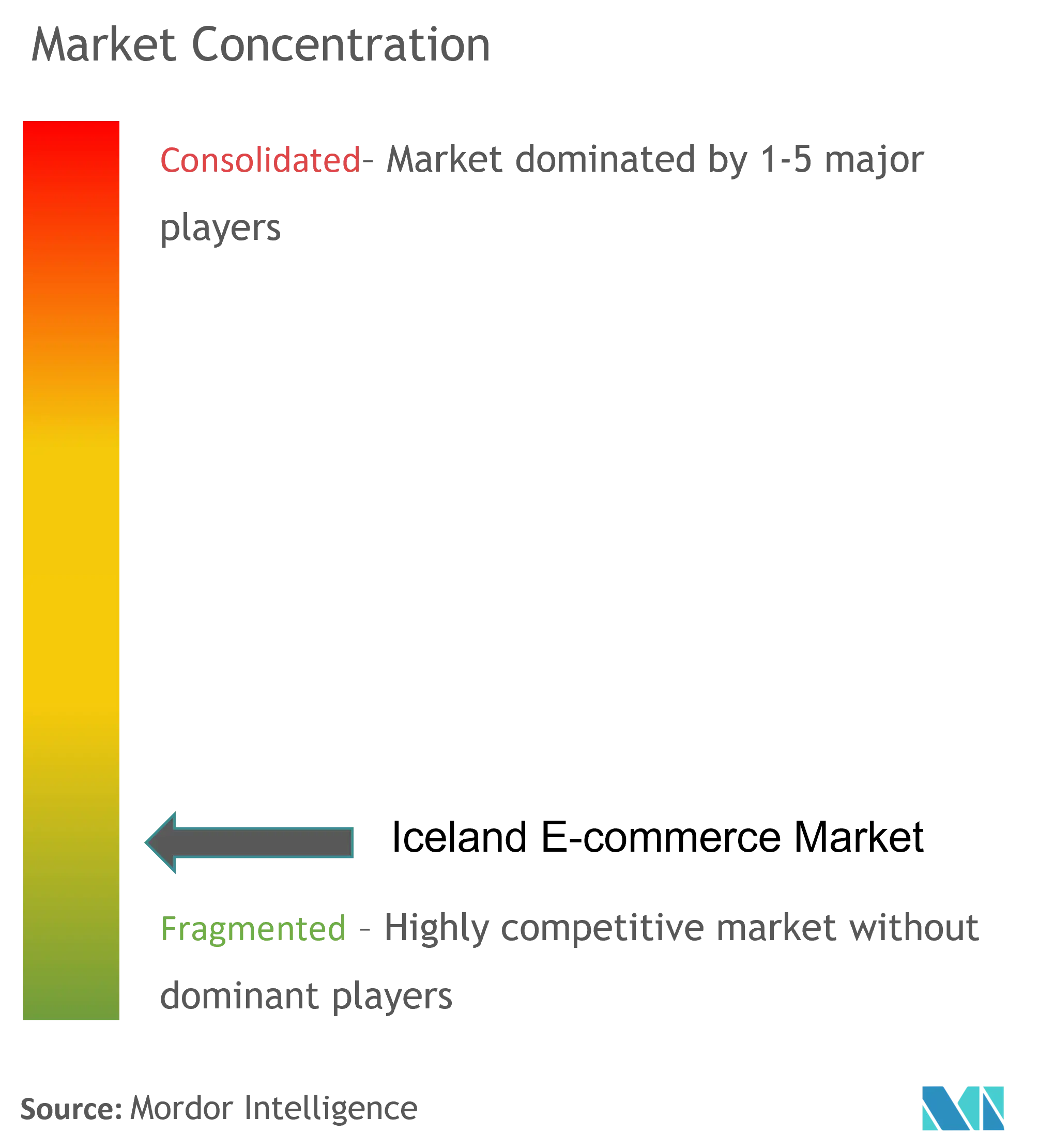
Iceland E-commerce Market News
- July 2021- Rapyd, a global fintech-as-a-service company, has entered into a definitive agreement with Arion Banki to acquire Valitor, an Icelandic payments solutions company, for USD 100 million. The acquisition of Valitor will complement Rapyd's existing payment capabilities throughout Europe and enhance its issuing portfolio. Valitor provides in-store and online payment acceptance solutions and card issuing to SMB merchants in Iceland, the United Kingdom, Ireland, and Europe.
Iceland E-commerce Market Report - Table of Contents
1. INTRODUCTION
1.1 Study Assumptions and Market Defination
1.2 Scope of the Study
2. RESEARCH METHODOLOGY
3. EXECUTIVE SUMMARY
4. MARKET INSIGHTS
4.1 Market Overview
4.2 Industry Attractiveness - Porter's Five Forces Analysis
4.2.1 Bargaining Power of Suppliers
4.2.2 Bargaining Power of Buyers/Consumers
4.2.3 Threat of New Entrants
4.2.4 Threat of Substitute Products
4.2.5 Intensity of Competitive Rivalry
4.3 Key Market Trends and Share of E-commerce of Total Retail Sector
4.4 Impact of COVID-19 on the E-commerce Sales
5. MARKET DYNAMICS
5.1 Market Drivers
5.1.1 Growing Number of E-shoppers is Expected to Boost the E-commerce Market
5.1.2 Strong Internet Penetration to Boost the E-commerce Market
5.2 Market Challenges
5.2.1 Challenges Related to High shipping Costs and High VAT
5.3 Analysis of Key Demographic Trends and Patterns Related to E-commerce Industry in Iceland (Coverage to Include Population, Internet Penetration, E-commerce Penetration, Age & Income etc.)
5.4 Analysis of the Key Modes of Transaction in the E-commerce Industry in Iceland (Coverage to Include Prevalent Modes of Payment Such as Cash, Card, Bank Transfer, Wallets, etc.)
5.5 Analysis of Cross-Border E-commerce Industry in Iceland (Current Market Value of Cross-border & Key Trends)
5.6 Current Positioning of Iceland in the E-commerce Industry in Europe
6. MARKET SEGMENTATION
6.1 By B2C E-commerce
6.1.1 Market Size (GMV) for the Period of 2017-2027
6.1.2 Market Segmentation - by Application
6.1.2.1 Beauty and Personal Care
6.1.2.2 Consumer Electronics
6.1.2.3 Fashion and Apparel
6.1.2.4 Food and Beverages
6.1.2.5 Furniture and Home
6.1.2.6 Others (Toys, DIY, Media, etc.)
6.2 By B2B E-commerce
6.2.1 Market Size for the Period of 2017-2027
7. COMPETITIVE LANDSCAPE
7.1 Company Profiles
7.1.1 Amazon.com Ltd
7.1.2 Inter IKEA Systems BV
7.1.3 Elko ehf
7.1.4 eBay Inc.
7.1.5 ASOS.com Ltd
7.1.6 AliExpress (Alibaba Group)
7.1.7 EPAL
7.1.8 Heimkaup
7.1.9 Hopkaup
7.1.10 Bland
7.1.11 Lin Design
- *List Not Exhaustive
8. Investment Analysis
9. Future Outlook of the Market
Iceland E-commerce Industry Segmentation
The Iceland e-commerce market is segmented by B2C e-commerce (beauty and personal care, consumer electronics, fashion and apparel, food and beverage, furniture and home), and B2B e-commerce.
| By B2C E-commerce | ||||||||
| Market Size (GMV) for the Period of 2017-2027 | ||||||||
|
| By B2B E-commerce | |
| Market Size for the Period of 2017-2027 |
Iceland E-commerce Market Research FAQs
What is the current Iceland E-commerce Market size?
The Iceland E-commerce Market is projected to register a CAGR of 14.80% during the forecast period (2024-2029)
Who are the key players in Iceland E-commerce Market?
Amazon.com, Inc., Inter IKEA Systems B.V, Elko ehf, eBay Inc. and ASOS.com, Ltd. are the major companies operating in the Iceland E-commerce Market.
What years does this Iceland E-commerce Market cover?
The report covers the Iceland E-commerce Market historical market size for years: 2019, 2020, 2021, 2022 and 2023. The report also forecasts the Iceland E-commerce Market size for years: 2024, 2025, 2026, 2027, 2028 and 2029.
Iceland E-commerce Industry Report
Statistics for the 2024 Iceland E-commerce market share, size and revenue growth rate, created by Mordor Intelligence™ Industry Reports. Iceland E-commerce analysis includes a market forecast outlook to 2029 and historical overview. Get a sample of this industry analysis as a free report PDF download.
